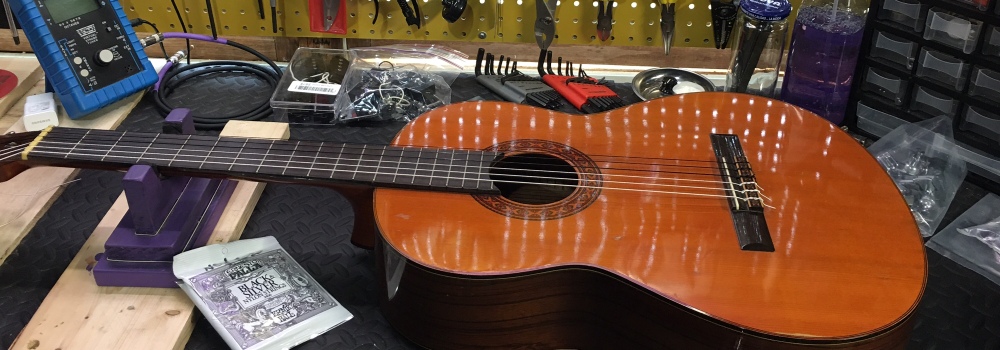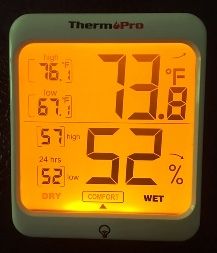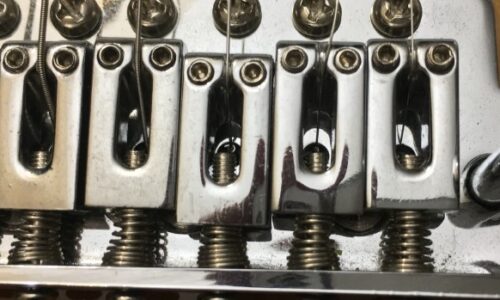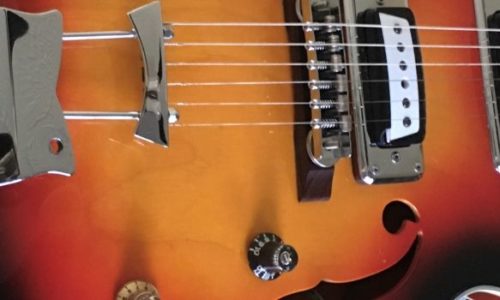How to Prevent Guitar Humidity and Temperature Problems

Guitar Care – Preventing Humidity and Temperature Problems
Learn how humidity and extreme temperatures affect guitars including steps you can take to avoid problems.
Regarding damage to guitars caused by heat and humidity factors there is one huge thing to remember. The number one thing to remember is “be diligent in avoiding troublesome conditions”! When heat or humidity damage your guitar it’s going to result is either expensive guitar repair services or a guitar that’s impossible to repair. Nobody wants either situation, right? Here’s what you need to know to take proper care of your guitar.
Types of Wood Used for Guitars
The types of wood used to build guitars include softwoods, hardwoods, laminated veneer, and even plywood. Within categories of softwood and hardwood, there are a variety of wood species used to build guitars. These types of woods are often mixed to build a guitar’s body, neck, and fingerboard. Sound Unlimted, a UK based guitar company, identified and described nearly a dozen types of woods used to build guitars.1 Every type of wood has its own unique characteristics. These unique characteristics manifest different effects form how each particular type of wood deals with humidity, dryness, and temperatures.
If you’ve ever seen warped boards or heard an old house creak at night then you’ve observed environmental effects on wood. Although not particularly discernable your guitar will react in a similar manner from atmospheric changes.
It is important to know that environmental effects on guitar wood also impact finishes, hardware fitment, and obviously playability. If you truly care about your guitar you will take time to learn how weather affects your instrument.
Hollow Body Guitars vs. Solid Body Guitars
Hollow Body Guitars – Temperature & Humidity
Hollow body guitars are basically thin sheets of wood with similarly light wood framing. Although the framing joints and veneer panels are firmly glued together when the wood swells the expansion leads to distortion. In other words, the endpoints and edges are locked-in-place. These elements cannot expand outward in size so the size expansion forces a concave or convex bowing. While this may settle down when humidity levels return to normal damage may remain.
Solid Body Guitars – Temperature & Humidity
Solid body electric guitar’s wood is generally not particularly affected by atmospheric conditions. The solid slab bodies are not likely to warp, although necks and fretboards are a bit more sensitive. For the most part, having larger, solid pieces of wood affords much greater resistance to temperature and heat changes.
Thinking past your guitars wood, you need to keep in mind that heat and moisture are two enemies of electronics.
How Does Temperature Affect a Guitar
We all know there is no way we can control the weather. Fortunately, guitars can usually be kept in climate controlled homes and buildings. As temperatures move from hot to cold wood reacts by expanding and contracting respectively. When the wood of a guitar experiences expansion and contraction there is a chance for warping and distortion. Both the body and the neck are susceptible to suffering irreparable damage.
Gradual temperature changes do not usually “shock” the wood as the guitar can adapt easily enough. When guitar experiences sudden and major temperature changes it can be a big problem. Taking a guitar out of a hot car and immediately taking it into an air-conditioned space is not a good idea. Taking a guitar from a cold outdoor environment into a warm room is not a good idea. These types of situations expose a guitar to sudden changes of 40 to 80 degrees or more – not good at all!
What is a safe temperature range for a guitar?
The extreme temperature ranges to which any guitar should be exposed is roughly 32-95 degrees Fahrenheit. Some sources may offer a wider range but it’s worth considering how these sources define “safe”. As for the ideal temperature range, Wikibooks2 says, “the temperature of the area should be about 65-75 °F (18-24 °C).”. Wikibooks goes on to advise that “The more expensive the guitar, the better your storage should be.”.
How to manage and control temperature effects on your guitar
To mitigate potential problems caused by temperature-related factors you should keep in mind:
- Avoid exposing your guitar to extreme temperatures. Having your guitar in a case will not protect it from sun-related temperature damage.
- Avoid moving your guitar between environments with temperature differences greater than 20 degrees Fahrenheit.
- Pay attention to the condition of your guitar. If you suspect temperature related problems, contact a nearby luthier.
How Does Humidity Affect a Guitar
Humidity, or lack of dissolved moisture in the air, causes wood to swell or shrink. While this is a normal occurrence, extreme changes will harm your guitar. In fact, Taylor Guitar’s website states, “It is essential to maintain a proper moisture level to prevent the adverse effects of dry conditions, such as bad string action and buzzing, protruding fret ends, wood cracking, top sinking, bridge lifting, and other damage to your instrument.”3. While you may not be able to see it with the naked eye, changes as little as 1/64″ can change your sound quality. Greater changes will exponentially have adverse effects on your guitar.
Sudden humidity changes will definitely change the playability of your guitar. For instance, if you fly from arid Phoenix, Arizona, to humid Houston, Texas, your guitar is going to seem like it has a mind of its own. The wood will absorb the moisture in the air and swell.
What is a safe humidity range for a guitar?
The generally recognized ideal humidity range for an acoustic guitar is between 40%-55% relative humidity. The fact is, that as humidity changes your guitar will change too. Stability in humidity means a more consistent playing feel and sound. Industry experts at Premier Guitar wrote an article that you should “…maintain a consistent humidity level for your instrument—particularly an acoustic hollow body. This will prevent a host of ailments and costly repairs…”.4
Controlling humidity in your home can also contribute to better health. Your heating and air system plays the largest role in regulating humidity; however, older systems don’t do much more than heat and cool. Does it really matter? Yes, it matters a lot. A recent article by a company in Naples, Florida stated, “The moisture in an indoor space may affect the way that people think, feel, and live. Specifically, the relative humidity of a house is one of the largest factors in the structure’s indoor air quality, equal to ventilation and the removal of contaminants. Since air quality affects people’s health, maintaining ideal control in the space where they spend most of their time is a vital goal.”5
How to manage and control humidity effects on your guitar
 The first thing you need to do is identify and monitor humidity levels where you keep your guitar. To do this you need to buy a Hygrometer and check it at least every few days. How often you check need to check it and take corrective measures, depends a lot on seasonal conditions where you live.
The first thing you need to do is identify and monitor humidity levels where you keep your guitar. To do this you need to buy a Hygrometer and check it at least every few days. How often you check need to check it and take corrective measures, depends a lot on seasonal conditions where you live.
If your acoustic guitar suddenly plays oddly consider the recent humidity levels before you do a search for a local luthier. The solution to your problem may be as simple as giving your guitar 4-5 days in the 45-50% humidity range.
Top 5 Humidity Control Products for Guitars
- ThermoPro TP 50 Hygrometer
- MusicNomad HumiReader
- AirCare Whole-House Evaporative Humidifier
- Kyser Acoustic Guitar Humidifier
- D’Addario Acoustic Guitar Humidifier
In Conclusion
If you own a guitar, temperature and humidity changes are elements of which you need to be aware. Usually keeping your guitars in the same room most of the time is a good plan. When you travel with your guitar try to keep it at a moderate temperature and humidity. It’s really pretty easy to do and will make a big difference in your guitar’s feel and performance.
FOOTNOTES
- 1 Rich Turner, “Guitar Tone Woods”, January 23, 2019, Available from Sound Unlimited
- 2 Wikibooks contributors, “Guitar/Guitar Maintenance and Storage”, October 3, 2017, Available from Wikibooks
- 3 Taylor Guitars, “Using a Guitar Humidifier”, November 13, 2018, Available from Taylor Guitars
- 4 John Levan, “Fighting the Humidity Battle”, February 04, 2013, Available from Premier Guitar
- 5 Mariette Mifflin, “How to Maintain Proper Humidity Levels in Your Home”, October 16, 2019, Available from The Spruce




I always keep my guitar in the case so that it is safe and out of direct sunlight. I regularly enlist the help of maintenance and Winnipeg guitar repair services to keep my musical instruments in proper shape. But some points that you have highlighted here to protect the guitar from moisture, I was not aware of it. Thanks for sharing this valuable information:)
Make millions in your spare time. Become a politician in Washington DC, pass bailout and foreign aid bills, make sure they send you a lot of the cash. Works everytime
If your guitar top gets affected by too much humidity, can you greatly reverse the humidity and correct the problem?
Thank you , you put everything I needed to know I bought two therm pros for my bedroom and living room as that is where I keep my 5 acoustic guitars and my one semi hollow electric guitar. It monitors the humidity and temperatures in each room I have a humidifier if I need it. I did not know any of this but since I bought my last two whole wood or all wood I have to learn so much as their prices are so high I don’t have the dollars to replace them. Thank you for help people like me that did not really know. God bless you all
Very good intel here. I usually keep my guitars in temp controlled bedroom. A hygrometer is a must-have, as it’s the best tool to monitor how they’re doin.’
I try to keep my guitar in one room where the humidity is always in a safe range. I bought a hygrometer online which lets me know if things are good. In the winter, when the heat is on, I sometimes place a small humidifier in the hall outside the door. That seems to be all I need to do to keep things right.
Very informative. Well done.
If your local outside temperature or humidity is over 5-10% of your home’s temp and humidity you should not have your guitar outside for more than 1-2 hours. The limited time outside of your home is even more critical when you are putting your guitar in a vehicle that is extremely hot.
Your blog post is one of the best I’ve been able to find. When I bought my acoustic gitar I had no awareness of how humidity affects playability and can damage my guitar. After reading this I bought a couple of things you suggested to control humidity problems. I feel better about my guitar and I’ve already found that it’s easier to keep it in tune day-to-day. 🙂